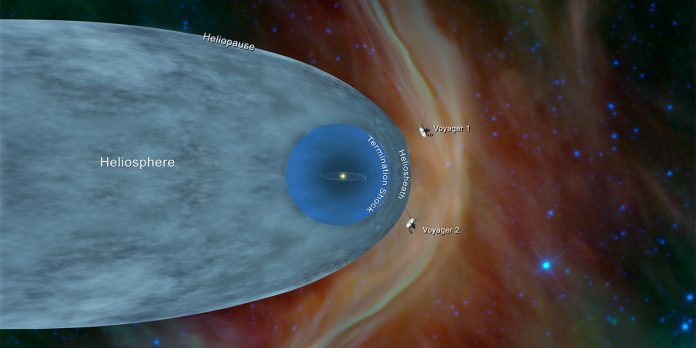HUNTSVILLE – Dr. Federico Fraternale at the University of Alabama in Huntsville has been awarded a $824,132 NASA heliophysics grant to develop global models of the heliosphere that incorporate interstellar neutral atoms that can help reveal the properties of space beyond the farthest reaches of the Sun’s influence.
A research scientist with the UAH Center for Space Plasma and Aeronomic Research, Fraternale will act as principal investigator for the initiative which will provide vital support to NASA’s Interstellar Mapping and Acceleration Probe (IMAP) mission, scheduled for launch in 2025.

“Only a few space missions provide observations from the outer heliosphere, beyond 10 astronomical units from the sun,” Fraternale said. A single astronomical unit is equal to the distance from the Earth to the sun – 93 million miles.
“And the data cover only a small portion of space and time. Thus, new models are essential for interpreting these observations. Our model stands as one-of-a-kind.”
Fraternale is in a UAH group with a rich history in heliophysics research led by professor Dr. Nikolai Pogorelov. The heliosphere is the outermost atmospheric layer of the Sun formed by the interaction of two magnetized flows: the solar wind—the flow of plasma originating from the Sun—and particles and gasses that make up the local interstellar medium, a gigantic region of space extending out 11.5 billion miles “upwind” of the Sun, roughly three times the distance to Pluto.
“The models suggest the heliosphere’s shape resembles that of a comet—with a nose and a long tail,” Fraternale said. “The LISM is partially ionized, meaning it is composed of a plasma component—primarily protons and helium ions, but also heavier ions and dust—and neutral atoms that are mostly hydrogen and helium. While the LISM plasma can’t penetrate the heliosphere due to the presence of a heliospheric magnetic field originating from the Sun, interstellar neutral atoms can, because they do not interact with the magnetic field.
Therefore, in principle, one can detect the flow of such neutrals and use it to infer the properties of the unperturbed interstellar medium, such as its direction, temperature, etc.”
Turning the data ‘inside-out’
The solution, however, is much more complicated. “We sit on Earth and cannot make direct measurements of the LISM,” Fraternale said. “Its properties are still subject to large uncertainties. We rely on remote observations, such as measurements of interstellar neutral atoms, galactic cosmic rays, etc.
“Voyager 1 and 2 are the only spacecraft measuring interstellar plasma in situ, from distances exceeding 160 au from the Sun.”
In plasma physics, the interstellar medium is made up of the matter and radiation existing between star systems in a galaxy and includes gasses, as well as dust and cosmic rays. The challenge to investigating these regions is the mind-boggling distances from Earth. The fundamental problem is this: due to the presence of the heliosphere, the LISM’s true nature is subject to modification when sampling particles traveling over these enormous distances and beyond.
“We are talking very large distances, on the order of 1,000 astronomical units in the direction of the heliospheric ‘nose,’” Fraternale said. “All available observations are affected by this complex interaction between the solar wind and the LISM and are not representative of the true properties of the unperturbed LISM. We are observing a system from its interior, and wish to know what is outside. I mentioned that interstellar neutral atoms can be used as a tool because they can enter the heliosphere.
“However, neutral atom distributions are heavily modified in the space regions both in front of the heliosphere and inside it.”
The UAH solution is to model the flow of interstellar neutral atoms to help bridge the gap. Thanks to a ‘hydrogen wall’ formed in front of the heliosphere, the atoms that eventually reach Earth represent only a fraction of the original population and are a mixture of the pristine, or unperturbed, population and the population of secondary atoms.
“This phenomenon is referred to as the ‘filtration effect,’” Fraternale said. “Which emphasizes the necessity of accurate modeling to interpret spacecraft data. Our models will aid in interpreting data from the Interstellar Boundary Explorer (IBEX) mission and future high-resolution data from IMAP.”
IMAP is a heliophysics mission that will orbit the Sun, simultaneously investigating two important aspects of the heliosphere: the acceleration of energetic particles and interaction of the solar wind with the local interstellar medium.
The satellite will also broadcast real-time in-situ data that can be used for space weather predictions. IBEX, launched in 2008, is a NASA spacecraft studying how our heliosphere interacts with interstellar space. IBEX created the first maps showing the interactions at the border of these regions, and how they change over time.
“My background is in fluid dynamics, focusing on instabilities and turbulence in fluids, as well as space plasma turbulence,” Fraternale said. “The modeling aspect of my research has been particularly beneficial, as many aspects of heliospheric physics require a global, 3D perspective. In this project, we will extend the model to incorporate elastic collisions and other important processes.
“Our models and numerical software are considered state-of-the-art for global simulations of the heliosphere and regarded as the most advanced available by many researchers.”
Don’t miss out! Subscribe to our email newsletter to have all our smart stories delivered to your inbox.



